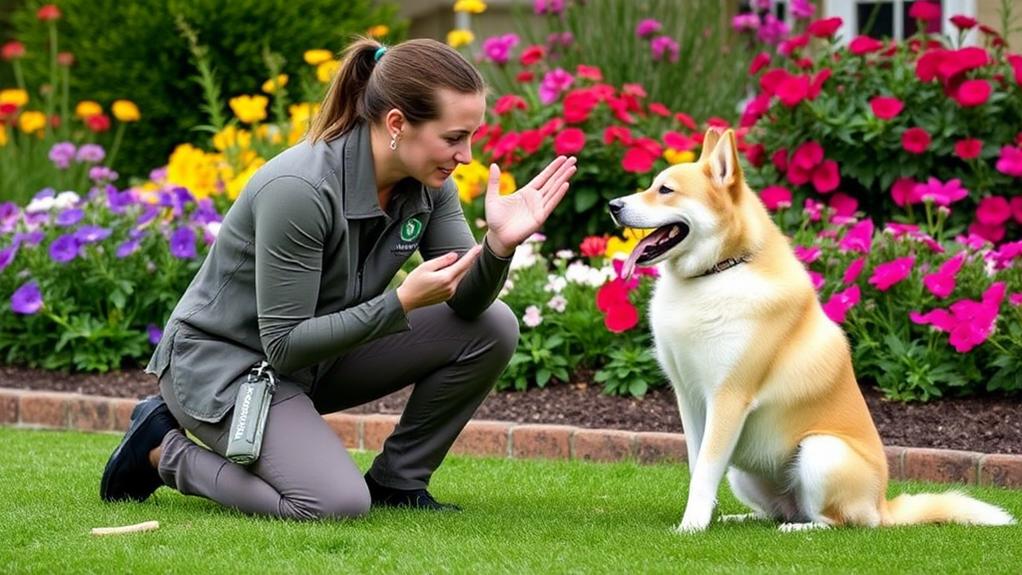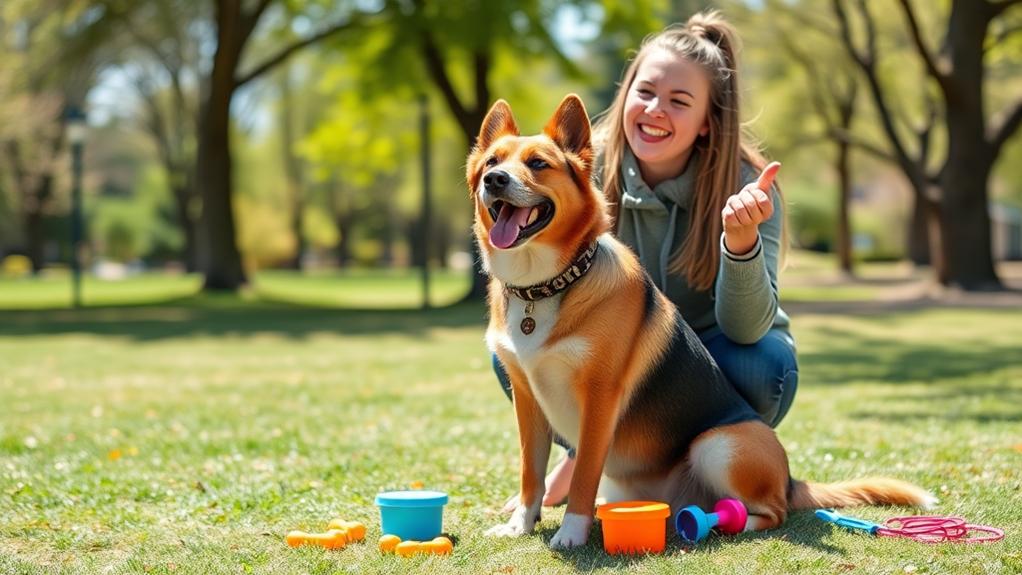Experimenting with hand signals in dog training can greatly enhance communication between you and your dog. Since dogs naturally respond well to body language, using clear, consistent signals helps them understand commands faster, even in noisy environments. Start with simple gestures paired with verbal cues, and keep practice sessions short and engaging. Always reward your dog immediately for correct responses to reinforce learning. Remember to be patient and maintain consistency across all commands. With practice, you'll deepen your bond and improve your dog's responsiveness even further. Discover how to refine your approach for even more success!
Benefits of Hand Signals
When it comes to dog training, incorporating hand signals can considerably enhance communication between you and your furry friend. Using visual cues allows your dog to understand commands more quickly, especially in noisy environments where verbal commands may be drowned out. Dogs are naturally tuned into body language, so they often respond better to your movements than to your voice alone.
Hand signals can also improve your dog's focus during training sessions. By pairing a signal with a command, you reinforce learning and make it easier for your dog to connect the behavior with the cue. This can lead to quicker and more reliable responses over time.
Moreover, hand signals are beneficial for dogs with hearing impairments. When you use both verbal and visual cues, you guarantee that all dogs, regardless of their hearing ability, can understand and follow your commands. This inclusivity fosters a deeper bond between you and your pet.
Choosing Appropriate Signals

Selecting the right hand signals is key to effective dog training. When choosing signals, think about clarity and consistency. Your dog should easily understand what each gesture means, so opt for simple movements that stand out. Avoid overly complex or subtle signals that might confuse them.
Consider your dog's ability to see and interpret your signals. If your dog is far away or distracted, a large, sweeping motion may be more effective than a small, quick flick of the wrist. Remember, the signals should be distinct from one another to prevent any mix-ups.
You'll also want to match the signal to the behavior you're teaching. For example, a pointed finger could indicate "come," while an upward palm might mean "sit." Test your chosen signals during training sessions to see how quickly your dog responds. If they seem confused, it's worth revisiting your choices.
Lastly, keep in mind that your signals should feel natural to you. You'll be using them often, so make sure they fit comfortably into your communication style. With the right signals, you're setting the stage for clear and effective interactions with your dog.
Training Techniques for Signals
Effective training techniques for hand signals can considerably enhance your communication with your dog. Start by choosing clear, distinct signals that you can consistently use. When you introduce a new signal, make sure to pair it with a verbal cue. This helps your dog associate the signal with the desired action.
Practice in a distraction-free environment to guarantee your dog can focus on you. Once your dog understands the signal, gradually increase the level of distractions. Use treats or toys as rewards to reinforce positive behavior. Timing is essential; reward your dog immediately after they respond correctly to the signal.
Keep training sessions short and engaging, ideally around 5 to 10 minutes, to maintain your dog's interest. If your dog seems confused or frustrated, take a step back and simplify the signal or the expectations. You want to build their confidence, not overwhelm them.
Consistency Is Key

Consistency in dog training is like the foundation of a house; without it, everything else can crumble. When you use hand signals, your dog needs to associate those signals with specific commands. If you change your signals or your reactions, your dog can become confused. Stick with one signal for each command, and use it every time you train.
Make sure everyone in your household is on the same page. If one person uses a different signal or behaves inconsistently, it can confuse your dog and slow down their learning. Consistency also extends to your timing and rewards. When your dog responds correctly, reward them immediately. This helps reinforce the behavior you want to see.
It's also essential to practice regularly. Short, frequent training sessions can help reinforce your signals and build a strong understanding. If you miss a day or two, it's easy for your dog to forget what they've learned. So, stay dedicated and patient.
Integrating Signals With Verbal Commands

Integrating hand signals with verbal commands can enhance your dog's training experience and improve communication. When you combine both methods, your dog learns to associate the visual cue with the spoken word, making it easier for them to understand what you want. Start by choosing a specific hand signal for each command, like a raised hand for "sit" and a sweeping gesture for "come."
Begin with verbal commands, and once your dog responds, introduce the corresponding hand signal. Use them together steadfastly during training sessions. Over time, your dog will start to respond to the hand signal alone, reinforcing their understanding and obedience.
Practice in different environments and situations to help your dog generalize the commands. If you're working on "stay," for instance, show the hand signal and say the command at the same time. Gradually reduce the verbal cue, allowing your dog to rely more on the visual signal.
This method not only strengthens your dog's learning but also builds a deeper bond between you two. Remember, patience and consistency are indispensable. Your dog will appreciate the clarity and connection you create through this integrated approach.
Common Mistakes to Avoid

Many trainers make common mistakes when using hand signals in dog training that can hinder progress and confuse their dogs. By being aware of these pitfalls, you can enhance your training effectiveness and strengthen your bond with your furry friend.
Here are three mistakes to avoid:
- Inconsistent Signals: Using different hand signals for the same command can confuse your dog. Stick to one clear signal for each command and use it consistently.
- Overly Complicated Gestures: Sometimes trainers create complex hand signals that are difficult for dogs to interpret. Keep your signals simple and easy to recognize, like an open palm for "sit" or a pointed finger for "come."
- Ignoring the Dog's Body Language: Focusing solely on your hand signals while ignoring your dog's responses can lead to misunderstandings. Pay attention to your dog's body language to gauge their understanding and make adjustments if needed.
Success Stories From Trainers

Countless trainers have experienced remarkable breakthroughs using hand signals in their dog training sessions. One trainer shared how their rescue dog, once anxious and unresponsive, transformed into a confident companion. By incorporating hand signals, they created a clear communication channel, which helped the dog feel secure and understood.
Another trainer reported that using hand signals allowed them to teach commands faster. With a visually engaging approach, their dog quickly grasped commands like "sit" and "stay." This visual learning method not only sped up training but also strengthened their bond.
A different success story involved a trainer working with a deaf dog. Utilizing hand signals turned out to be a game-changer. The dog learned to respond to visual cues, proving that communication isn't limited to sound. Trainers found that hand signals became a fun and effective way to engage dogs of all backgrounds.
These stories highlight the versatility and effectiveness of hand signals in dog training. They show how you can reveal your dog's potential, foster a deeper connection, and achieve lasting results with this innovative approach. So, consider integrating hand signals into your training routine; you might just witness your own success story unfold.
Practicing With Your Dog

When you practice hand signals with your dog, start in a quiet space where distractions are minimal. This helps your dog focus on you and the signals you're using. Begin with one signal at a time, ensuring your dog understands what you expect before moving on to the next. Consistency is key, so use the same signal for the same command each time.
Here are three tips to enhance your practice sessions:
- Pair with Treats: Use treats to reward your dog immediately after they successfully respond to your hand signal. This positive reinforcement strengthens their understanding.
- Keep Sessions Short: Dogs have limited attention spans, so keep training sessions to about 5-10 minutes. Frequent short sessions are more effective than longer, drawn-out practices.
- Gradual Increase in Difficulty: Once your dog masters a signal, gradually introduce distractions or practice in different locations. This helps them generalize the command, making it reliable in various environments.
With patience and consistency, your dog will learn to respond to your hand signals, making communication between you both much clearer. Enjoy the bonding experience that comes with training!
Measuring Progress in Training
Measuring progress in dog training is essential for understanding how well your dog is grasping hand signals. You can start by setting clear, achievable goals for each training session. For instance, if you're teaching your dog the "sit" signal, aim for them to respond correctly at least 80% of the time by the end of the week.
Keep track of your dog's performance by noting their responses during practice. Use a simple chart or a notebook to record how many times they follow your hand signals correctly versus incorrectly. This not only helps you see improvement but also identifies areas needing more focus.
Additionally, observe your dog's body language. If they seem enthusiastic and attentive, it's a good sign they're understanding the signals. Conversely, if they appear confused or disinterested, it might indicate a need for a different approach.
Conclusion
Incorporating hand signals into your dog training can enhance communication and strengthen your bond. By choosing clear signals, being consistent, and practicing regularly, you'll see progress in no time. Remember to integrate these signals with verbal commands for the best results. Avoid common pitfalls, and soon you'll be sharing success stories of your own. Keep practicing, stay patient, and enjoy the journey with your furry friend as you both master this rewarding training method together.



